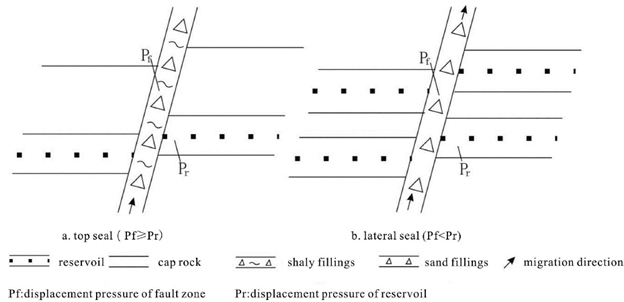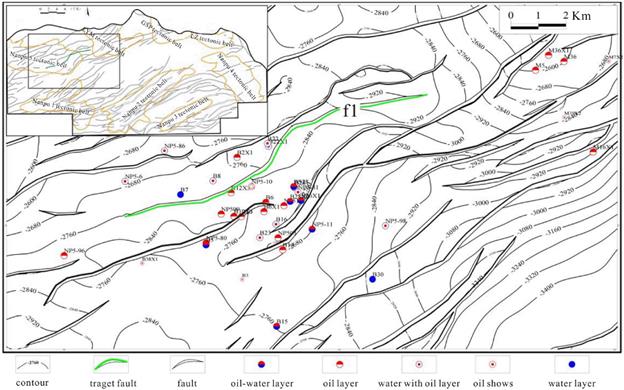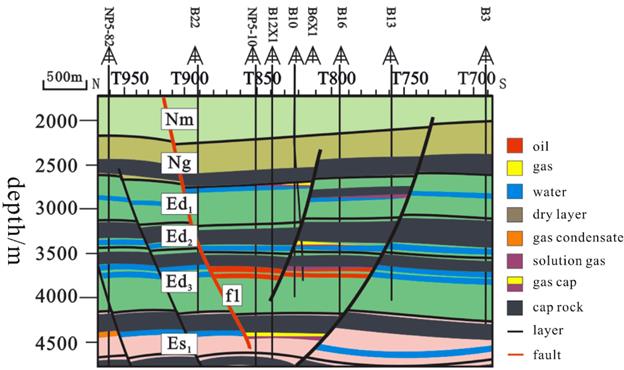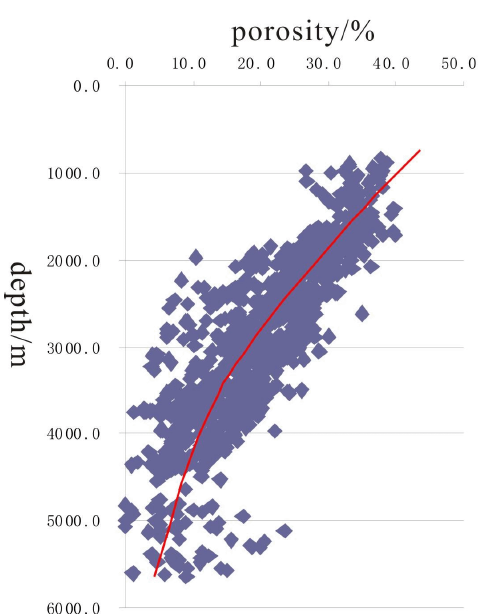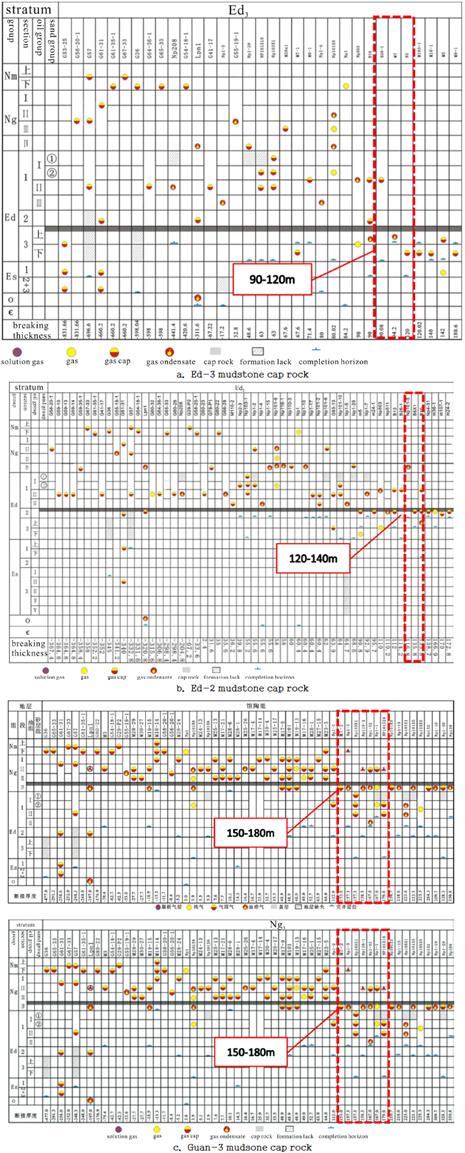Introduction
In oil and gas bearing basins, due to the different stopping time of different fractures, the fracture fillings of the compaction and diagnosis degree of are different, and the vertical sealing ability of oil and gas will also be different, thus different vertical distribution characteristics of oil and gas are resulted. It can correctly understand that the vertical sealing mechanism and ability of fracture fillings with different compaction, the diagenetic degrees is very important for oil and gas exploration in fault development areas of the bearing basins. There are a lot of researches and discussions on the vertical sealing ability of oil and gas in fractures. There are mainly two methods concluded. One is to study whether the oil and gas in fracture are vertically sealed or not based on relative magnitude between the positive pressure on the fault surface and the plastic deformation limit of mudstone. If the positive pressure on the fracture is greater than the limit of plastic deformation of mudstone, then the mudstone in the fault zone plastically flows and blocks the leakage space left after the fracture is closed, and a vertical sealing is formed, otherwise, vertical seals cannot be formed. Another method is to treat the fracture as a layer of rock that is dumped in a surrounding rock stratum. By measuring the depth of solid buried rock and mud content in fault rock, this paper uses the empirical relationship between measured displacement pressure of surrounding rock and compacted burial depth and mud content to determine the displacement pressure and calculate the displacement pressure. This paper compares the relative magnitude of the displacement pressure of fault rock and the displacement pressure of the rock in the bottom reservoir, and studies the vertical closed oil and gas in the fault. However, these two methods are both aimed at the study of vertical sealing oil and gas of the fault rock type fractures in the stationary phase faults. In the meanwhile, relatively few studies have conducted on the vertical sealing oil and gas of the non-rock type fault in the stationary phase, and some are only qualitative, lacking quantitative research, which is undoubtedly unfavorable to further exploration of oil and gas in the fault development area of the oil and gas bearing basin. Therefore, it is of great significance to study the method of evaluating the vertical sealing ability of unconsolidated faults in stationary phase for correct understanding of the distribution of oil and gas in fault development zones of the oil and gas bearing basins and guiding oil and gas exploration.
The Necessary Conditions for the Vertical Sealing of Oil and Gas of Unconsolidated Faults in the Stationary Phase
The fracture just stopped its activities. Due to its relatively shallow burial, the pressure of the overlying sedimentary load is relatively small, and the fault filling has not been compacted and diagenetic. Now, whether or not the oil and gas can have sealed in fractures in the upright vertical direction depends on the relative sizes of the fracture filling displacement pressure and the rock replacement pressure in the underlying reservoir. If the fracture filling displacement pressure is greater than or equal to the underlying replacement pressure of reservoir rock, then the fracture is closed vertically, as shown in Figure 1a. On the contrary, if the fracture filling displacement pressure is less than the underlying displacement pressure of reservoir rock, then the fracture is not closed vertically, as shown in Figure 1b. From this, it can be seen that the conditions required for vertical sealing of oil and gas in the unconsolidated fault in stationary phase should be that the fracture filling is dominated by argillaceous matter, while the fracture of the argillaceous fracture filling should be faulted in the mudstone seal.
Determination Methods of Fracture Filling Compaction and Diagenesis
In order to determine whether the fracture filling is compacted and diagenetic, it is assumed that the fault rock and surrounding rock should have the same compaction and diagenesis history. Thus, the initial porosity and compaction diagenesis coefficient of the fault rock should be the same as that of surrounding rock. The inverse relationship (Equation 1) between the compaction diagenesis degree of the fault rock and the surrounding rock with the same burial depth, which can be considered as its diagenetic pressure and action time, and the ratio of the porosity can be used to derive the fault rock compaction diagenetic burial depth Zf, which is shown in Equation 2.
In the equation:
Z-fault rock burial depth, m;
Zf-fault block compaction diagenetic burial depth, m;
Tf-fault rock compaction diagenetic time, Ma;
Ts-compaction diagenetic time of surrounding rock with the same burial depth as the fault rock, Ma;
pw-density of formation water, g/cm3;
Φ o-initial porosity of surrounding rock, decimal;
C-surrounding rock compaction diagenetic coefficient.
From Equation 2, taking Zf=0 (indicating that the fracture filling is not compacted into rock), the time for the fracture to start compaction and diagenesis is shown in Equation 3. If the Tfo is earlier than the fracture stopping time To, then the fracture filling is not compacted diagenetic, on the contrary, if the time Tfo for starting compaction and diagenesis of the fracture filling is later than the fracture stopping activity time To then the fracture filling has started compaction and diagenesis. The compaction diagenetic time can have calculated by Equation 4.
Evaluation method of vertical sealing ability of oil and gas of unconsolidated fractures of fault in stationary phase
It can be seen from the above that it is necessary to determine the displacement pressure of the fracture filling and the displacement pressure of the underlying reservoir rock to judge whether the unconsolidated fractures in the stationary phase seal off oil and gas.
Determination of displacement pressure of fracture filling
Due to the limitations of drilling and coring, it is impossible to test the displacement pressure of the fracture filling directly at present. It can only be determined indirectly through the experimental results of the physical model. In order to obtain an empirical relationship between the fracture filling displacement pressure and the pressure and mud content, clay and silt are mixed to simulate fracture filling with different mud content according to the ratio of 100:0, 80:20, 60:40, 40:60, 20:80 and 0:100 respectively, poured into a stirrer and stirred evenly, and moistened with an atomizer. A manual pressure pump has used to apply pressures of 1 MPa, 5 MPa, 10 MPa, and 15 MPa to simulate fracture filling under conditions of 100 m, 500 m, 1000 m, and 1500 m underground respectively. Then, 20 pieces of fracture filling samples with a diameter of 2.5 cm will be taken out, compressed, dried, vacuumized, and treated with saturated kerosene. Finally, the samples have placed in the core holder and the displacement pressure has tested using high-pressure solid gas. The results are shown in Table 1. By mathematical regression between the test results of displacement pressure of the fracture filling and the pressure and mud content in Table 1, the formula for calculating the displacement pressure of the fracture filling by using the pressure and the mud content of the fracture filling is available as shown in Equation 5. The pressure of the fracture filling Nf in Equation 5 is calculated by the Equation 6 according to the burial depth, Rf in Equation 5 can be calculated from Equation 7 based on the fault displacement and the thickness and mud content of the formation that is faulted by it.
Table 1 The measured displacement pressure and the pressure and mud content data of the fracture filling material
| Sample No. | Depth(m) | Displacement Pressure | Mud Content(%) |
|---|---|---|---|
| 1 | 1500 | 2.11 | 100 |
| 2 | 1500 | 1.10 | 80 |
| 3 | 1500 | 0.54 | 60 |
| 4 | 1500 | 0.32 | 40 |
| 5 | 1500 | 0.19 | 20 |
| 6 | 1000 | 0.86 | 100 |
| 7 | 1000 | 0.50 | 80 |
| 8 | 1000 | 0.31 | 60 |
| 9 | 1000 | 0.18 | 40 |
| 10 | 1000 | 0.12 | 20 |
| 11 | 500 | 0.41 | 100 |
| 12 | 500 | 0.28 | 80 |
| 13 | 500 | 0.18 | 60 |
| 14 | 500 | 0.12 | 40 |
| 15 | 500 | 0.08 | 20 |
| 16 | 100 | 0.26 | 100 |
| 17 | 100 | 0.16 | 80 |
| 18 | 100 | 0.12 | 60 |
| 19 | 100 | 0.08 | 40 |
| 20 | 100 | 0.06 | 20 |
In the equation:
Pf-fracture filling actual measured displacement pressure, MPa;
Nf-pressure on fracture filling, MPa;
Rf-fracture filling mud content, decimal.
 Equation 6 (Huiting, Long & Yan, 2014)
Equation 6 (Huiting, Long & Yan, 2014)
In the equation:
Rf-fracture filling mud content, decimal;
Hi-thickness of Layer i stratum that faulted by faults, m;
Ri.-mud content of Layer i stratum that faulted by faults, decimal;
n-number of strata that have been faulted by faults;
L-fault displacement, m.
Determination of displacement pressure of underlying reservoir rock The displacement pressure of the underlying reservoir rock can be obtained by direct coring test. If there is no core, it can also be calculated by the empirical correlation (Equation 9) between the measured displacement pressure of the reservoir rock in the study area, the compacted diagenetic burial depth, and mud content by using its compacted diagenetic burial depth. If there are no obvious overlying strata of the uplift and denudation, and it can be replaced by the current burial depth and the mud content, which can be calculated by Equation 8 using its natural gamma data.
In the equation:
GR-natural gamma-ray logging value of target formation;
GRmax-natural gamma-ray logging value of mudstone formation;
GRmin-natural gamma-ray logging value of sandstone formation;
IGR-natural gamma relative value;
GCUR-the empirical coefficient related to formation, 3.7 for new formation, 2.0 for old formation.
Pr-measured displacement pressure of reservoir rock, MPa;
Zr-reservoir rock compaction diagenesis burial depth, m;
Rr-reservoir rock mud content, decimal;
a,b-constants related to area.
Evaluation of vertical oil and gas sealing capacity of unconsolidated faults in stationary phase
By comparing the relative size of the above-identified fracture filling displacement pressure and the displacement pressure of underlying reservoir rock, the vertical oil and gas sealing ability of the unconsolidated fracture in the stationary phase can be evaluated. If the fracture filling displacement pressure is greater than or equal to the displacement pressure of underlying reservoir rock, then the fracture has closed vertically, conversely, if the fracture filling displacement pressure is less than the underlying displacement pressure of reservoir rock, then the fracture is not closed vertically.
Example Application
Selecting the f1 unconsolidated fault of the Nanpu No.5 structure in the Nanpu Sag of the Bohai Bay Basin as an example, using the above method, this paper studies the vertical sealing ability of the stationary phase in the first, second and third sections of the Dongying Formation. Through the analysis of the relationship between the research method and distributions of oil and gas found in the first, second and third sections of the Dongying Formation of Nanpu No. 5 structure at present, the feasibility of the proposed method in evaluating the vertical sealing ability of the unconsolidated faults in the stationary phase is verified.
Table 2 The measured displacement pressure of the reservoir rocks in the south of the depression and its compaction and the data of the depth of the rock and the mud content
| Well No. | Depth/m | Mud Content/% | Displacement Pressure/Mpa |
|---|---|---|---|
| G49 | 2448.6 | 5.64 | 0.89 |
| NP1-37 | 3045.5 | 8.79 | 0.62 |
| M28x10 | 3268.6 | 24.48 | 1.34 |
| G62 | 4054.6 | 22.28 | 1.31 |
| NP5-10 | 3320 | 32.4 | 2.82 |
| NP4-510 | 2449.79 | 54.6 | 3.18 |
| B7 | 3597.58 | 38.7 | 4.12 |
| M5 | 2768.36 | 51.21 | 3.77 |
| G3106 | 3899.5 | 36.52 | 2.06 |
| B5 | 4219.4 | 35.89 | 4.25 |
| M108x1 | 3345.3 | 46.16 | 3.11 |
The Nanpu No. 5 structure is located in the northwest of the Nanpu Sag. It is an important oil and gas bearing structure in the Nanpu Sag. The structure feature is generally a draping structure developed on the background of buried hill, and its tectonic direction is northeast to east. It is complicated by near-east-west fracture cutting, as shown in Figure 2. The formations developed from the bottom to the top are the Kongdian Formation, the Shahejie Formation, the Dongying Formation of the Paleogene, and the Guantao Formation, the Minghuazhen Formation ofthe Neogene, and the Quaternary. Up to now, this structure has verified a large number of oil and gas shows in Shahejie Formation and Dongying Formation. Among them, there are relatively more showing in the first, second, and third sections of Dongying Formation, as shown in Figure 3. The f1 fault is located in the core section of Nanpu No. 5 structure, of which the trend is northeast or east, with a relatively large scale of extension, as shown in Figure 2. The displacement of the lower part of f1 fault is larger than the upper part, and the average displacement is 70-145m. The dip varies greatly from 49o-72o. From Sha-1 member of f1 fault to the ground surface, the fracture filling has not compacted and consolidated so far. Whether it can form vertical sealing for oil and gas in the first, second and third sections of the Dongying Formation should be the key to oil and gas exploration in the Dongying Formation of Nanbao No. 5 Structure. The burial depth of f1 fracture in the first, second and third sections of the Dongying Formation can be obtained from Figure 3, and the compacted diagenetic time (deposition time since its inception) of the surrounding rock with the same burial depth as the f1 fracture can be obtained from the geological time scale. The diagenesis coefficient of the surrounding rock and the initial porosity can be determined from Fig. 4. Calculated from the Equation 3, the time of compaction and diagenesis of the f1 fracture is 6.58Ma, which is obviously earlier than the f1 fault stopping activity time (0Ma), indicating that the f1 fracture has not been compacted and consolidated although the activity has stopped so far. From the burial depth of the fault f1 in the first, second, and third sections of the Dongying Formation, and the pressure received by the fracture filling can be calculated from Equation 6, and then from fault displacement of the fault f1 in the first, second and third section of the Dongying Formation. The thickness of the stratum faulted and mud content have calculated by Equation 7, the mud contents of the fracture filling are 0.27, 0.29, and 0.31 respectively. Finally, the pressure received by fracture filling of f1 fault in the first, second, and third segments of the Dongying Formation and mud content are substituted into Equation 5, and the displacement pressures of the f1 fault filling in the first, second, and third sections of the Dongying Formation are calculated as 0.41 MPa, 0.59 MPa, and 0.75 MP, respectively. From the compaction diagenetic burial depth of reservoir rocks in the first, second and third sections of the Dongying Formation, where the fault f1 is located, because there is no significant uplift and erosion, and it can have replaced by the current burial depth. The natural gamma logging has calculated by Equation 8, the mud contents of reservoir rocks in the first, second and third sections of Dongying formation are 0.15, 0.17, and 0.10 respectively. The compaction diagenetic burial depth and mud content of reservoir rocks in the first, second and third sections of the Dongying Formation have substituted into the relationship between the Nanpu Depression reservoir rock measured displacement pressure and its compaction diagenetic burial depth and mud content, where we can see in Table 2 and Equation 10. The displacement pressures of reservoir rocks in the first, second and third sections of the Dongying Formation are 0.12 MPa and 0.15 MPa and 0.10 MP respectively.
Comparing the relative size among the displacement pressures of the fracture f1 filling in the first, second and third sections of the Dongying Formation and the displacement pressure of the underlying reservoir rock. It can be seen that the displacement pressures of the fault fracture f1 filing in the first, second and third sections of the Dongying Formation are greater than them of the underlying reservoir rocks. In addition, the fault is close vertically, which is conducive to the accumulation and preservation of oil and gas in the first, second and third sections of the Dongying Formation.
In the equation, Pr, Zr, and Rr have the same meaning as the Equation 8.
Seeing from Fig. 3, there is oil and gas showing in both Ed-1 and Ed-3 ofthe f fault in Nanpu 5 structure. Although the f fault is not compacted as diagenetic, the displacement pressure of fracture filling is greater than that of the underlying reservoir rock, which is conducive to the accumulation and preservation of oil and gas. Moreover, during the f1 fault activity, the breaking thickness of the Guan-3 member volcanic cap rock and the Ed-3 mudstone cap rock (173m and 177m, respectively) is greater than the minimum breaking thickness required for sealing oil and gas (Figure 5). Oil and gas cannot transport and dissipate upward along f1 fault. It is also conducive to hydrocarbon accumulation and preservation. There is no oil and gas showing in Ed-2 because the breaking thickness of the mudstone cap rock in Ed-2 (110m) is smaller than the minimum breaking thickness required for sealing oil and gas (Figure 5). The f1 fault activity is connected up and down in Ed-2 mudstone cap rock. Thus the underlying oil and gas dissipate along the fracture of f1. Even though the displacement pressure of the fracture filling is greater than the displacement pressure of the underlying reservoir rock after the gas stops moving, and it is vertically sealed, there will be no accumulation of oil and gas.
Conclusions
The required condition for the vertical sealing of oil and gas of unconsolidated fault in the stationary phase is that the fault being fractured should be mudstone cap rock. Based on the predicted time for the initiation of compaction and diagenesis of the fault filling and the time when the fracture ceases activity, compaction and diagenesis can be determined. If the time that the fault filling begins to form earlier than that the fracture stops activity, then the fault rock is not compacted and consolidated, otherwise it is compacted and consolidated.
In this paper, the displacement pressure of the fault filling and the rock mass of the bottom reservoir is determined, and the both relative sizes have compared. In this paper, a set of evaluation methods for the vertical sealing ability of the loose phase and the stationary phase has established. It has applied to the vertical oil and gas seal of the first, second and third sections of the Dongying Formation by the fixed-phase structural loose fault f1 in the Blocking ability evaluation of Nanpu Sag, Bohai Bay Basin. The results show that the displacement pressure of fault filling of f1 fault in the first, second and third sections of the Dongying Formation is greater than the displacement pressure of the underlying reservoir rock, and it is vertically closed, which is conducive to oil and gas accumulation and preservation. It matches the existing discovered oil and gas distributions in the first, second, and third sections of the Dongying Formation near the f1 fault of the Nanpu No.5 structure. It shows that the method is feasible to evaluate the vertical oil and gas sealing ability of the unconsolidated faults in the stationary phase.













